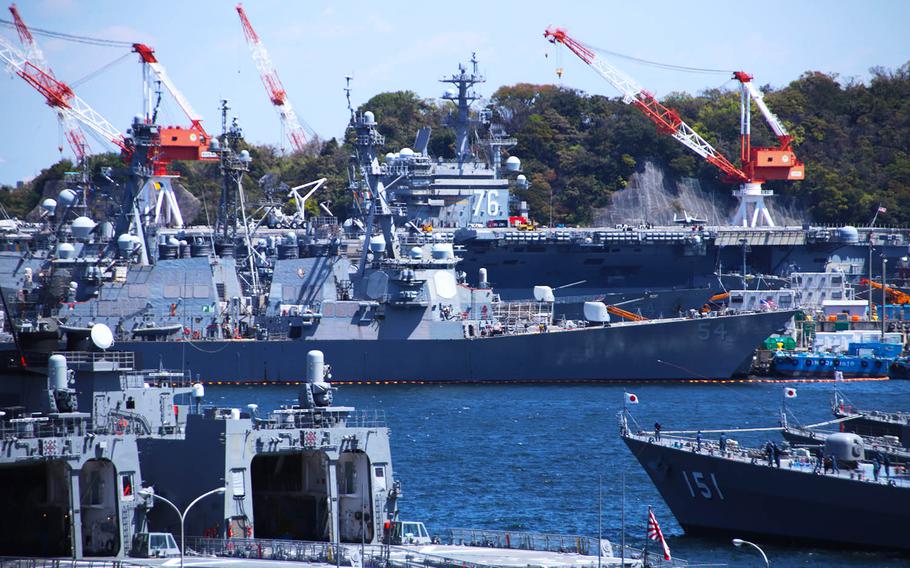
The aircraft carrier USS Ronald Reagan stands above other Navy and Japan Maritime Self-Defense Force ships at Yokosuka Naval Base, Japan, April 14, 2020. (Akifumi Ishikawa/Stars and Stripes)
Stars and Stripes is making stories on the coronavirus pandemic available free of charge. See other free reports here. Sign up for our daily coronavirus newsletter here. Please support our journalism with a subscription.
YOKOSUKA NAVAL BASE, Japan — An undisclosed number of sailors from the USS Ronald Reagan strike group tested positive for coronavirus after a Task Force 70-ordered sequestration period, a Navy spokesman said Tuesday.
The sailors showed no symptoms and were tested over the weekend as their mandated isolation came to an end, said Task Force 70 spokesman Lt. Cmdr. Sean Brophy in an email Tuesday. Those who tested positive did not board any ships and were isolated instead, he said.
All crew members of the Reagan and its strike group are sequestered and tested for the virus before embarking ahead of an upcoming deployment, Task Force 70 commander Rear Adm. George Wikoff told Stars and Stripes on Friday.
The strike group includes the Reagan and the accompanying guided-missile cruisers and destroyers that deploy alongside the aircraft carrier.
Wikoff didn’t say how long the sequestration period was, but Navy guidance suggests a 21-day restriction of movement for a “99% ‘clean’ confidence level.”
Those sailors who tested negative over the weekend boarded their ships, Brophy said.
He said catching the positive cases among sailors who otherwise appear healthy “highlights how our measures are working as they were designed to.”
The sequestration plan is preventing the virus’ spread by screening sailors and isolating those who have tested positive, Brophy said.
The sailors who tested positive had been sequestered at Naval Air Station Atsugi and Yokota Air Base in Japan but were not in contact with either base community, Brophy said. Others were sequestered at Marine Corps Air Station Iwakuni and at Yokosuka.
The Reagan and its strike group typically patrol the western Pacific from late spring through early winter, undergoing regular maintenance in the interim.
As they gear up for another deployment to the Indo-Pacific, Navy commanders must also ensure the illness that sidelined another aircraft carrier in the Pacific last month doesn’t come aboard the Reagan or the ships of its strike group.
“We will continue to learn and adjust accordingly, but the sailors’ health is always the first priority before we go to deployment,” Wikoff said. “I would not be taking a sailor underway on any of our ships if I was concerned about the health of the crew.”
Several Reagan sailors tested positive for the coronavirus before the pre-boarding sequestrations began. Officials have not disclosed how many, but the New York Times on April 22 reported 16 positive cases associated with the carrier.
Wikoff and Reagan commander Capt. Pat Hannifin spoke with Stars and Stripes about the precautions being taken for the Reagan and its strike group in a joint phone interview Friday.
“Americans everywhere are facing adversity in their own ways right now and while that is happening, they count on us to stand the watch,” Hannifin said.
In the past six weeks, China has sent a carrier strike group through the Miyako Strait near Okinawa, sank a Vietnamese fishing vessel in the South China Sea, deployed maritime militias around the contested Spratly Islands and established new “research stations” there on the disputed Fiery Cross and Subi reefs, Secretary of State Mike Pompeo said in a statement Thursday.
“Even as we fight the outbreak, we must remember that the long-term threats to our shared security have not disappeared,” he said. “In fact, they’ve become more prominent. Beijing has moved to take advantage of the distraction.”
The amphibious assault ship USS America and its expeditionary strike group are patrolling the South China Sea, but no U.S. aircraft carrier is patrolling the western Pacific since the coronavirus in March sidelined the USS Theodore Roosevelt. Since then, nearly a fourth of the carrier’s 4,000-member crew has tested positive for the virus, and one has died.
“Our mission is to provide that lethal combat force to the nation with no caveats for difficult times or for difficult challenges or circumstances and that is exactly what we’re doing,” Hannifin said. “We’re taking the precautions necessary to prevent [the coronavirus] and mitigate the effects of that onboard Reagan.”
The unprecedented event has posed a unique challenge to the strike group, Wikoff told Stars and Stripes on Friday. In his role, Wikoff oversees the Reagan strike group and Task Force 70, which is the battle arm of the 7th Fleet.
“A cookie-cutter ‘here’s what you do in case of this’ answer is not out there as we continue to learn about this virus,” Wikoff said.
“I think it means a lot not only to our sailors of our strike group but also to our nation as a whole and our partners and allies that we get Reagan back to sea and back out on deployment where she belongs,” he said.
When they deploy, the Reagan and its strike group will join other 7th Fleet ships that have been at sea since February, including the guided-missile cruiser USS Antietam and the guided-missile destroyers USS Mustin and USS McCampbell. The destroyer USS Barry on Friday steamed through the 110-mile-wide Taiwan Strait, which China views as its territorial waters but the U.S. considers an international waterway.
Wikoff said he hopes returning the Reagan and its strike group to sea will send a message to U.S. allies and partners “that we are here with them to promote common interest.”
“The world remains a competitive space and competition remains out there,” he said. “We will continue to fly, sail and operate as international law allows in this theater.”
“The mission endures,” he said.